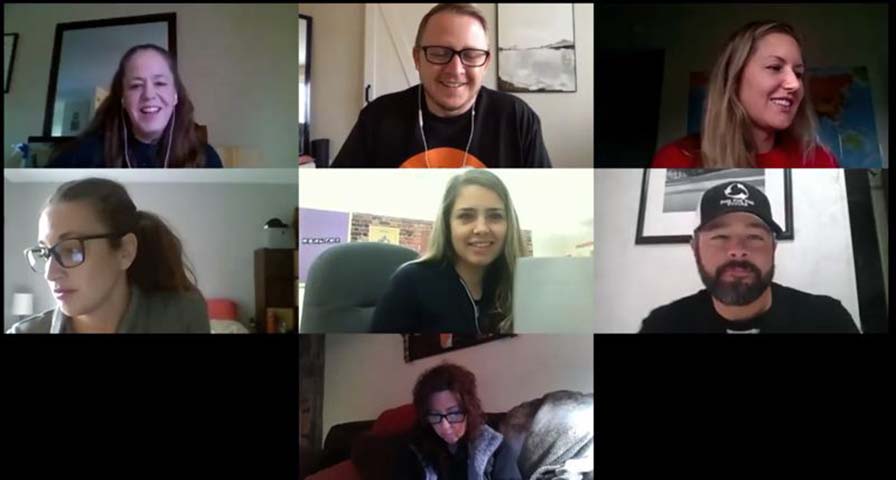Originally published Nov. 9, 2020 by Sandy Post.
By Brittany Allen
As schooling has moved online because of the COVID-19 pandemic, teachers have had to become increasingly flexible. For some, distance learning has even changed their role with students almost entirely.
Such is the story of the seven health and physical education teachers for Cedar Ridge, Boring and Welches middle schools.
 While these educators still offer some virtual physical education instruction, their jobs have become less about teaching children keys to physical fitness and more about ensuring students are properly equipped not only with tech support and access to teachers, but with tips for maintaining mental wellness during these trying times.
While these educators still offer some virtual physical education instruction, their jobs have become less about teaching children keys to physical fitness and more about ensuring students are properly equipped not only with tech support and access to teachers, but with tips for maintaining mental wellness during these trying times.
"We've been wearing quite a few hats this year," said Christopher Cramer, health educator for both Boring and Cedar Ridge middle schools.
"We've been able to be creative in ways we wouldn't have been in the past," added Boring Middle School educator Mandy Vance.
Fortunately, the seven health and physical education teachers are used to working as a team to educate children across the Oregon Trail School District. Every year, they work in tandem to coordinate and improve lessons based on past experiences. However, their roles now have them teaming up in a much different realm.
Besides working one-on-one with students to address problems with technology, help them get connected to teachers and fill gaps where they have questions, the health and wellness team has also been tasked with creating instructional videos for students to watch in the mornings or in between classes. These videos address everything from "Why it's important to have your camera on for Google Classroom" to mental, emotional and social health needs of students.
"What's really unique about our teaching is we've never had curriculum given to us," Vance explained. "We've all worked together to create curriculum. But it's crazy how well suited we are to do this."
"We have this really unique group of people, you never could've guessed would be in these roles," Cramer added.
While the team members find their combined skill set beneficial to the current learning environment and their jobs, that does not mean these changes come without challenges.
"I considered myself a pretty tech savvy person before this, but I'm still learning all the tools," Cramer explained. "We all have to be tech support and problem solvers."
"One of the things that's obviously really hard is we're not face to face with students or each other," Vance said. "We're trying hard to still teach students healthy habits and how to cultivate a healthy mindset while in these uncertain times. I also write all of our advisory curriculum and it's challenging thinking through how everyone will interpret what you're writing. Every decision being made right now is in light of what is going to help every single kid."
"I think teachers are doing the best they can," she added. "We're constantly adapting and learning and changing things as we go. At the end of the day, the students are kids and we have to let them be that also. We want to create things that kids enjoy."
Cramer explained that that's why they try to make their videos "education with a side of entertainment, to lighten heavy times."
"This is the world students live in regardless of distance learning," Cramer added. "They're on their phones (constantly), so we're meeting them where they're at."
Being helpful to both teachers and students has definitely helped lighten the heavy times for these educators as well.
"I miss students so much," Vance said. "I probably speak on behalf of most teachers in saying that. These kids imprint on your life. We typically have this really unique relationship with kids. We're their coaches; we get to cheer them on and watch them grow. Some kids thrive in physical education but not academic classes. (Being in these advisory roles) helps us a lot because we don't get the everyday connection with students, so this is connection. I think it's important for people to know that as hard as this time is, teachers care about their students."
"(Now we're looking at) 'How can I create that (opportunity) in this environment,'" Cramer added. "We look at this as a service for both students and teachers."
All of the wellness educators do still offer some virtual physical instruction, but those classes at the middle school level aren't compulsory. Students have to want to engage in led stretches or other at-home exercises.
"As wellness educators, our heart is in this. We hope this is helpful," Vance said. "We're really in a different subject area (while in distance learning) but we're working on 'How can we still get students what they need?' I don't know that we'll entirely go back to how things were, even as a nation. Now that we've introduced technology to students in this way, I think it creates a new medium of education"
"I think as a team we've tried to address 'How can we make sure what we're doing has legs longer and go past the time of distance learning?'" Cramer added. "Our hope is whatever we have worked on, lives on. I hope people understand how much time teachers are putting in to reinvent themselves as teachers to meet the current needs of kids."
Seeking information about the IHT Spirit System?




